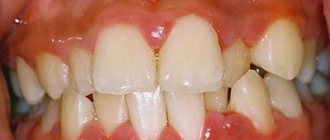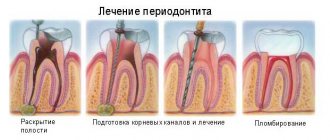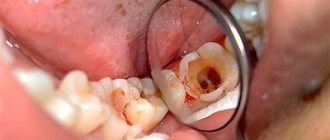Chronic periodontitis is one of the forms of the disease that occurs due to the fact that pathogenic microorganisms penetrate into the periodontal tissue through the openings of the root canals located at the tops of the dental roots. Chronic periodontitis of the roots is accompanied by a violation of the integrity of the ligaments that provide fixation and stability of the tooth, destructive processes of bone tissue and can lead to the formation of granulomas and large cysts.
Chronic periodontitis is a pathological process in the periodontal tissues. This is associated with the development of inflammation in the periodontium and the formation of fibrous, granulating, granulomatous tissue. In the chronic form of the disease, exacerbations periodically occur, during which swelling of the gums, loosening of teeth, the appearance of fistulas with the release of pus, etc. are observed. Specialists identify this pathology and distinguish it from similar diseases using electroodontometry, X-rays and visual examination. Lack of proper treatment leads to tooth loss due to weakening of the ligamentous apparatus and the growth of large capsules with pus.
Filling made of light-curing material for classes I and V - 2,000 rubles.
Filling made of light-curing material in classes II, III, IV - 3,000 rubles.
Placing a temporary filling - 400 rubles.
Resection of the root apex (frontal group) - 6,500 rubles.
Resection of the root apex (chewing group) - RUB 9,000.
Mechanical and medicinal treatment of canals for periodontitis (1 canal) - 1,100 rubles.
Closing perforations (MTA) - RUB 6,500.
At CELT you can get advice from a dental specialist.
- The cost of a dental consultation is 1,000
- The cost of an orthodontist consultation is 2,000
Make an appointment
Symptoms of the disease
General symptoms depend on the form of the pathology. When granulomas form, attacks of pain are observed when exposed to hot food. Pressure on the affected tooth and gum is accompanied by pain. The size and density of the mucosa in the affected area changes, and a granuloma forms under the bone or mucosa.
An exacerbation is accompanied by the appearance of fistulas, which grow and gradually release their contents into the oral cavity. In this case, purulent fistulas can appear not only on the gums, but also on the cheekbones, cheeks, neck, and chin. Isolation of pus may be performed along with the isolation of granulosa tissue. Then the fistula goes away, and a scar appears in its place.
The granulomatous form occurs for a long time without pronounced symptoms. Only after the granuloma grows to a large size and cysts form, the main symptoms appear: discoloration and severe pain in the tooth, development of gumboil and swelling of the gums in the affected area. Cysts that are too large can cause a jaw fracture and long-term rehabilitation.
Fibrous periodontitis is the most hidden form of pathology. There is no pain when chewing food or drinking hot drinks. Severe symptoms are observed only during exacerbation. There is general poisoning of the body due to the penetration of pus into the blood, the tooth becomes loose, and the lymph nodes in this area become larger.
Periodontitis
Periodontitis is a common disease among both children and adults, which occurs as a result of complications of caries. In this case, the connective tissue between the cement of the tooth root, responsible for the stability of the tooth, and the bone of the socket is affected, and the nerve (pulp) is affected, which dies and disintegrates, which leads to infection of the jaw under the tooth. Since pulp tissues have a large number of receptors, when they grow and pressure, the tooth begins to hurt. To cure periodontitis, you need to remove the infection in the root canal of the tooth.
If you do not consult a doctor in a timely manner, then with any form of periodontitis, complications, both local and general, begin to develop. This is a gumboil that develops into phlegmon, an abscess, and cysts that begin to touch nearby tooth roots, and when it suppurates, a fistula can form. Sometimes cysts grow into the maxillary sinus. In addition, complications of periodontitis cause intoxication of the body due to infection, causing headaches or fever. It happens that an acute form of osteomyelitis can be diagnosed, as a result of which the bone jaw tissue begins to deteriorate.
Do not delay treatment indefinitely! Dr. Razumenko's dental clinic in Moscow has all the necessary equipment and modern drugs that allow all procedures to be carried out comfortably and effectively.
Causes of chronic periodontitis
Chronic periodontitis appears in the absence of treatment of the acute form. The disease develops due to traumatic, toxic, infectious, mechanical effects on tissue.
The infectious form develops due to the penetration of pathogenic microorganisms into the oral cavity. This is due to damage to soft tissues by staphylococci, diphtheroids, and streptococci. The penetration of bacteria into tissues occurs through the openings of the root canals or through the hematogenous route. Often the infection progresses against the background of osteomyelitis, sinusitis, periodontitis, and tonsillitis.
The fibrous form often progresses after severe trauma. For example, after tissue destruction with a pin, filling, or crown. Pathology can also develop due to a strong blow.
Drug-induced periodontitis occurs due to the use of drugs that provoke coagulative necrosis of the periodontal ligament. These include resorcinol-formalin and arsenic paste. Tissue poisoning is provoked by local anesthesia, iodine, acids, etc.
Indications
The lack of a positive result after conservative and surgical treatment is the main indication for removal of affected teeth. Extraction is performed for the following symptoms:
- Significant damage to the crown.
- Severe loosening of the tooth.
- Formation of large cysts and granulomas.
- Impossibility of performing the operation due to obstruction of the canals.
- Lack of results with surgical and conservative treatment.
Contraindications
- Oral infections.
- Allergy to anesthesia.
- Intolerance to antibiotics and antimicrobial agents.
- Acute diseases of the cardiovascular system.
- Poor blood clotting.
Features of the treatment of fibrous periodontitis
The most important feature is that in most cases, the fibrous form of periodontitis found in a patient allows treatment to be avoided. It is not necessary:
- upon confirmation of the fact of tooth treatment for any other forms of periodontitis, as well as pulpitis or deep caries;
- if there are no patient complaints;
- when the fillings (if any) do not raise doubts about their high quality and no complaints about their condition.
If there are defects in the previously installed “root filling” or it is completely absent, then appropriate treatment is necessary, which takes place in several stages, requiring repeated visits to the dental office.
During the first visit, the doctor will examine a photograph of the tooth to determine the number and patency of the canals and an approximate estimate of their length and location. Then, after local anesthesia, he will open the tooth cavity and thoroughly clean the canals using special antiseptics. After this, the doctor will expand the canals to the optimal diameter while simultaneously removing all damaged tissue, and perform a temporary filling of the tooth cavity with calcium-containing preparations placed in the canals.
At a second visit (after 3-5 days), temporary filling materials will be removed while the canals are re-treated with antiseptics. If no unpleasant symptoms arise while wearing a temporary filling and no unpleasant odor is emitted from the canals, they are filled with permanent materials. To control the quality of treatment, a repeat image is prescribed, after which the outer part of the tooth is restored.
If after the first dose the patient complains of pain, then the treatment regimen changes:
- The dentist can remove all temporary filling materials, leaving the tooth open for several days, prescribing rinsing its cavity and taking broad-spectrum antibacterial drugs.
- The second option is also possible: the tooth is not opened, but instead a surgical incision is made along the transitional fold with a dissection of the periosteum, and an elastic drainage is installed. Treatment is carried out under local anesthesia; upon completion, antibiotics are prescribed.
After the symptoms of exacerbation of the disease are relieved, treatment is continued as usual.
Types of chronic periodontitis and their clinical manifestations
It is customary to distinguish several forms of the disease, the diagnosis of which is necessary in order to correctly prescribe treatment for chronic periodontitis. To do this, the dentist conducts a visual examination of the oral cavity, prescribes electroodontic diagnostics and x-rays.
Chronic fibrous periodontitis
Self-diagnosis of this type of chronic periodontitis is very difficult due to the almost complete absence of clinical manifestations.
The patient does not experience pain, and there is no reaction to temperature stimuli. During the examination, the dentist notes a change in the color of the tooth, the presence of a reaction to percussion and painful probing. The tooth cavity is filled with dead pulp, which emits a putrid odor. The X-ray image clearly shows the increase in the periodontal fissure at the root apex; there is no destruction of bone tissue and cement.
Chronic granulating periodontitis
The painful sensations characteristic of this type of chronic periodontitis are not significant.
There are sensations of heaviness and fullness, and minor pain may be present when exposed to mechanical stimuli. Exacerbation of chronic granulating periodontitis is accompanied by the formation of a fistula through which pus comes out or granulation tissue grows. With this disease, the gums become loose. When pressing on the inflamed area with the blunt end of a dental instrument, a small depression appears, which disappears only after some time. The x-ray image shows the focus of the destructive processes of bone, dentin and cement.
Chronic granulomatous periodontitis
The symptoms of chronic periodontitis of this type are also practically invisible to the patient. Sometimes minor discomfort and pain may occur when biting on the affected tooth.
An examination by a dentist can reveal a change in the color of the crown of the tooth, but a carious cavity is not necessarily present. Remnants of dead pulp are found in the root canals. If the canals were previously sealed, then the quality of the filling is not good enough.
An X-ray image allows you to determine the destruction of bone tissue, which has a round shape. Often this process can be found on dental tissues or the root apex area.
Diagnostics
The diagnosis is made by a dentist-therapist based on the patient’s complaints and characteristic symptoms. Carrying out X-ray diagnostics in the initial stages of the disease is difficult, since changes are noted already in the presence of periodontal pockets.
Marginal periodontitis is differentiated from the apical form of the disease, in which the inflammatory focus is in contact with the apex of the tooth root, and does not form at the gingival margin. The pathology must be distinguished from gingivitis and periodontitis, in which periodontal tissue is not damaged.
Treatment of the chronic form
Good patency of the canals allows for therapeutic treatment:
- Opening a tooth.
- Antiseptic treatment.
- Cleaning the channels.
- Use of anti-inflammatory drugs.
- Installation of a temporary filling.
After the procedure, antibiotics are prescribed and re-appointed after 3 months. If the x-ray shows a cure for the disease, then the canals are treated with an antiseptic and a permanent filling is installed. Surgical intervention involves cystectomy, resection of the upper part of the root, hemisection, and root removal. Lack of results after treatment is a reason for extraction of the diseased tooth.
Treatment
The treatment procedure for marginal periodontitis differs from conventional methods of treatment for dental diseases. In this case, there is no need to open the root canal and carry out its sanitation.
The choice of treatment method depends on the condition of the pulp. If it is not damaged, the disease is treated as periodontal disease - this is a long and complex process, but it allows you to get rid of the problem without surgery and opening the crown of the tooth. This method includes anti-inflammatory and antimicrobial therapy.
In more complex cases, when the pulp has not been preserved, the gum pocket is treated with a special antiseptic solution. First, the procedure is carried out in the clinic, then the patient must rinse independently at home. In case of accumulation of pus in the gum pocket, an incision is made to ensure the outflow of fluid.
In the most advanced cases, the only correct solution is tooth extraction, which is a last resort measure for treating the disease.
Exacerbation of chronic periodontitis
Often patients seek treatment for acute chronic periodontitis, which manifests itself quite clearly. This mainly applies to granulomatous and granulating types, exacerbations of which occur much more often than fibrous types. Clinical manifestations during this period include:
- constant localized pain;
- swelling of soft tissues;
- the presence of a reaction to mechanical stimuli;
- painful reaction of the lymph nodes.
Classification of periodontitis
Dental classification of periodontitis is necessary, since on its basis the degree of the disease is diagnosed and treatment is prescribed. Periodontitis is classified according to the following indicators
:
- Depending on the location of the source of inflammation, periodontitis can be divided into marginal, apical and apical (marginal) ;
- chronic and acute, depending on the course of pathological processes, in which it is specified how much the affected tissue has changed ( purulent, serous, chronic fibrous, granulomatous or granulating );
- distribution intensity: single or multiple ;
- by severity: purulent or acute serous periodontitis .
Recommendations after treatment
After conservative or surgical treatment, you should not eat food for 2-3 hours due to the effects of anesthesia. Pain may be experienced for 7 days after surgery. It is recommended to rinse your mouth with antiseptics and a decoction of medicinal herbs. For severe pain, it is recommended to take painkillers. If pain persists and severe swelling is observed, contact your doctor immediately.
At the same time, the crown of the tooth changes its color, the presence of a carious cavity and tooth mobility are noted. Dentists at the CELT clinic successfully treat even the most advanced and severe forms of chronic periodontitis!
Make an appointment through the application or by calling +7 +7 We work every day:
- Monday—Friday: 8.00—20.00
- Saturday: 8.00–18.00
- Sunday is a day off
The nearest metro and MCC stations to the clinic:
- Highway of Enthusiasts or Perovo
- Partisan
- Enthusiast Highway
Driving directions
Our prices
| Code no. | Name of procedures | Unit of measurement | Cost, rub. |
| 300 | Application anesthesia | 100,00 | |
| 301 | Infiltration anesthesia, conduction | 450,00 | |
| 401 | Mechanical treatment of the canal with hand tools | 800,00 | |
| 403 | Drug and ultrasound treatment of the canal (repeated) | 500,00 | |
| 404 | Filling with temporary (therapeutic) material. | 500,00 | |
| 405 | Canal filling using lateral condensation method | 1000,00 | |
| 305 | Placement of a light-composite filling (Esthet-X, Filtek) | 2 800,00 |
* The prices indicated on the website are not a public offer. The exact cost of treatment can only be determined at an appointment with a doctor.
Prices for treatment in Korolev full price list
Share on social media networks:
Article Expert:
Konoplya Larisa Mikhailovna
Orthopedic dentist - general practitioner. Education: Minsk State Medical Institute. Regularly improves his professional level at international seminars and conferences.
Work experience 30 years
Causes
The pathology is caused by an infection that penetrates through the periodontal pocket resulting from trauma or a medical burn.
During the period of primary occlusion, marginal periodontitis occurs due to caries in the cervical area of the tooth. The affected milk unit is capable of transmitting infection to the permanent tooth during the period of mixed dentition.
The reason for the development of bacteria is poor oral hygiene, which creates a favorable atmosphere for reproduction. The waste products of pathogens form dental plaque, which mineralizes over time into stone.
The cause of the disease can also be careless or unprofessional dental treatment, as a result of which a filling or crown grows under the gum due to rough pushing of dental materials and instruments.











